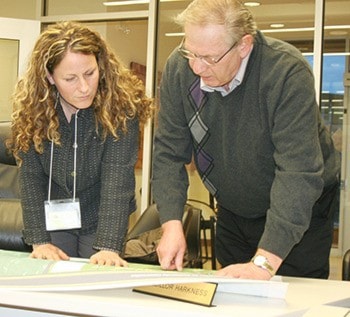An open house to explain a Biodiversity Conservation Strategy for the South Okanagan-Similkameen entitled, “Keeping Nature in our Future,” was held at the Princeton Library conference room March 4.
Regional District of Okanagan-Similkameen Planner, Malcolm McNaughton, MCIP and Bryn White, program manager of the South Okanagan-Similkameen Conservation Program presented the strategy to Princeton and Area H residents, Princeton Council and Area H director, Brad Hope.
Keeping Nature in our Future is a strategy for the South Okanagan-Similkameen that identifies, “Why we should conserve and restore natural areas, which natural areas should be protected and restored, who can contribute, how and when conservation and enhancement of these natural areas can be achieved, and the role of natural areas in protecting regional biodiversity.”
Some of the key findings in the report are listed as;
Nearly two-thirds of the study area is classified as having high or very high conservation ranking.
More than 20 percent of the study area is classified as having high or very high relative biodiversity.
Approximately 13 percent of the study area falls within lands designated as parks, with most of this consisting of provincial parks and protected areas. Municipal, regional, and provincial parks and protected areas together protect only 22.6 percent of the region’s very high and high biodiversity habitats.
During the open house, McNaughton and White presented key findings, challenges and opportunities specifically for Princeton and Area H. Some of these are;
Ranking in importance for biodiversity:
Princeton land base: approximately 44 percent, Area H land base contains approximately 61 percent.
In Princeton, six percent of those ecosystems are protected through open space or conservation lands and in Area H, 10 percent.
It is noted that compared to the remainder of the RDOS, Area H contains 34 percent of the very high and 41 percent of the high relative rankings.
Examples of challenges for both areas are reported as;
“The grasslands around Princeton and to the north act as a hub or core habitat are with multiple valleys connecting and distributing out. These areas are important corridors for connectivity in all directions.”
“Increasing development at Otter Lake and Chain Lakes is decreasing the biodiversity values in those areas, and the valley corridors they are part of.”
The strategy states the South Okanagan-Similkameen is a biologically unique area with species and ecosystems that do not exist anywhere else in Canada, and in some cases, the world. It is recognized as one of Canada’s most endangered natural systems.
Wildlife and natural areas in the South Okanagan-Similkameen have been affected negatively because of the impact of towns, cities, agriculture and other human activities on both water and land.
Keeping Nature in our Future provides options that local governments, landowners and residents can use to help protect the natural assets of the region that provide the basis for environmentally sustainable development now and for future generations.
To view the full document, local area reports and the zoom-able maps of the areas studied, please visit www.soscp.org and choose Keeping Nature in our Future.
